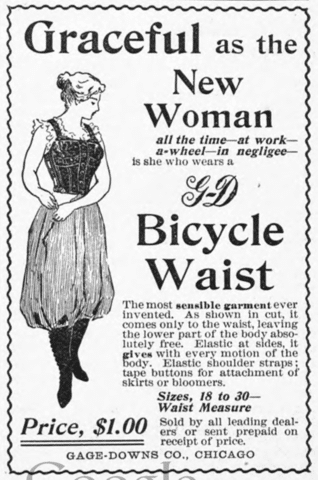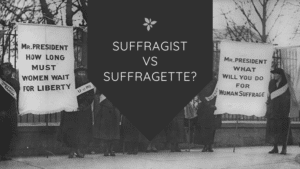How did women’s fashion change from the restrictive corsets and heavy petticoats worn for centuries, to the more comfortable and practical clothes available today? The Rational Dress Movement of the Victorian era played a small role in women casting off their cumbersome clothing.
Women’s Fashion in the Victorian Era
Women’s fashions in Victorian times emphasized an hourglass figure, with very full skirts and a tiny waist. The layers of petticoats needed to fill out skirts could weigh up to 30 pounds.
The desired tiny-waisted look was achieved by wearing a corset and padding. Corsets were worn almost universally by women (and some men) every day throughout much of the 19th century, and were thought to be necessary not only for aesthetic reasons, but for correct posture and good health.
Fabric, ornamentation, and the overall elaborateness of an outfit all indicated a woman’s social status. Wealthier women could afford more luxurious fabrics and elaborate trimmings. Accessories like hats, gloves, parasols, and fans were essential to a complete Victorian outfit.
The Rational Dress Movement

Towards the end of the 19th century, women were becoming more involved in sports and strenuous activities like bicycling, swimming, cricket, ice-skating, and roller-skating. Heavy skirts were too cumbersome for these activities, and corsets restricted breathing.
Women wanted to be able to participate in these activities while wearing more safe and comfortable clothing. Various reformers spoke out against the restrictive fashions of the time, and argued for more rational dress.
The rational dress movement was made up of many different individuals in various countries. Some grouped together to form organizations such as the Rational Dress Society, which was founded in 1881 in London.
What Was the Rational Dress Society?
The Rational Dress Society was a group formed in 1881 in London as part of a larger movement pushing for reform in Victorian dress, particularly for women. They were critical of the impractical and often unhealthy aspects of popular fashions.
Here’s a closer look at their mission and impact:
- Opposing Unhealthy Trends: The Society strongly opposed fashion elements that restricted movement, deformed the body, or potentially harmed a woman’s health. This included tight corsets, heavy skirts, high heels, and restrictive cloaks.
- Promoting Practicality and Comfort: They advocated for clothing designed with comfort and practicality in mind. This meant garments that allowed for freedom of movement and didn’t restrict activities.
- Focus on Health: The Society believed clothing should promote good health, not hinder it. Tight corsets were a major target as they could cause breathing difficulties and organ displacement.
The Rational Dress Society used various methods to promote their views, including lectures, publications, pamphlets, and even hosting a public exhibition showcasing “rational dress” options.
While the Society didn’t completely revolutionize fashion, it did contribute to a gradual shift towards more practical and comfortable clothing for women, especially with the rise of activities like cycling.
The Rational Dress Society was part of a broader movement for women’s rights and social change. Their focus on dress reform reflected a desire for women to have more control over their bodies and lives.
The Bloomer Suit
One of the most famous efforts of the Rational Dress movement was the invention and attempted adoption of “bloomers.”

Bloomers are named for activist Amelia Bloomer, but she actually didn’t invent them. In fact, a temperance activist from New England named Elizabeth “Libby” Smith Miller was the first to begin wearing the costume, which consisted of loose pants gathered at the ankles, topped with a full dress or skirt the ended just under the knees.
The famous suffragist Elizabeth Cady Stanton loved the outfit and thought it very sensible. She, in turn, introduced it to Amelia Bloomer. A newspaper publisher, Amelia Bloomer used her paper to advocate for the new outfit. Her efforts to publicize the outfit resulted in it being nicknamed the “Bloomer suit,” and women who wore it were called “Bloomers.”
Despite her efforts, the costume never caught on. Tired of putting up with ridicule and harassment everywhere she went, Amelia Bloomer eventually gave up on the outfit herself in favor of the new crinoline petticoat, which was somewhat lighter than the heavy layers of petticoats that were fashionable previously.
Results of the Rational Dress Movement
The rational dress movement is actually thought to have had little effect on changing mainstream fashion. As long as the hourglass silhouette was in style, corsets were still considered indispensable.
However, the movement did have some success in changing the style of undergarments, since they were hidden and not subject to ridicule like the Bloomer suit. A looser, more comfortable “reform corset” started to gain popularity in the early 20th century.
Though the Rational Dress Movement had little influence, the influence of women gaining more rights and independence did have an influence. Women also needed clothing more suited to swimming, riding bicycles, and playing sports.
But the biggest influence on the loss of corsets was the fickle nature of changing fashions. By the early 20th century, the empire silhouette of the early 19th-century was back in style, and silhouettes became more soft and flowing instead of heavily structured and hourglass-shaped. The corset was no longer needed to achieve the desired outline, so it soon fell out of fashion.
Keri is a blogger and digital marketing professional who founded Amazing Women In History in 2011.






Leave a Reply